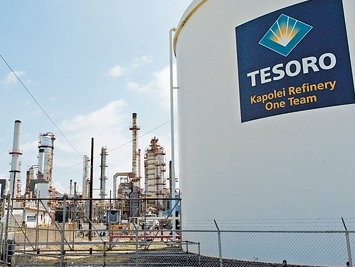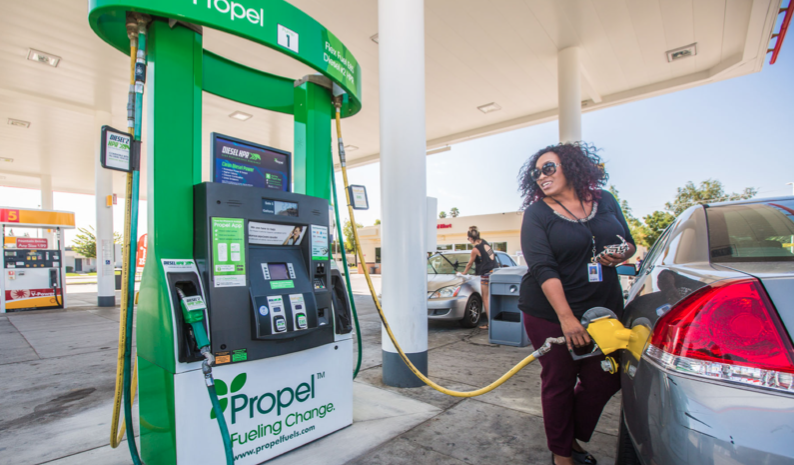For anyone wondering how things are going in California with compliance to AB 32 and the 2016 revision demanding that greenhouse gas emissions be scaled back 40 percent to 1990 levels by 2030, here’s a quick case study. Marathon Petroleum Co. is asking for permission to generate Low Carbon Fuel Standard (LCFS)  credits at its Tesoro refinery in Martinez, located in the East Bay of the San Francisco Bay Area. California Air Resources Board posted a refinery project application for public comment on Sept. 20, which will close on Sept. 30, 2019.
credits at its Tesoro refinery in Martinez, located in the East Bay of the San Francisco Bay Area. California Air Resources Board posted a refinery project application for public comment on Sept. 20, which will close on Sept. 30, 2019.
You can read CARB’s summary of the project, which the agency said it plans to endorse if all the received comments are addressed satisfactorily by Marathon. In 2017, the company took on an electrification project that replaced a natural gas-fired turbine with an electric motor that drives the refrigeration compressor at the alkylation unit. The project also reduces criteria air pollutants and toxic air contaminants emitted by the refinery. (By the way, the Tesoro brand name is going away following a 2017 rebranding as Andeavor Corp. and a $23.3 billion merger last year of Andeavor and Marathon. Now everything falls under the Marathon corporate logo.)
The Martinez refinery has crude oil capacity of 161,000 barrels per calendar day (bpcd), and employs about 740 workers. Marathon’s other California location, the Los Angeles Tesoro refinery based in Wilmington, has crude oil capacity at 363,000 bpcd, about 1,620 employees, and is the largest refinery on the west coast. Marathon is earning additional LCFS and other California credits at the Watson Cogeneration Plant located within the Wilmington refinery’s complex. The cogeneration plant produces 400 megawatts for local refineries and sells excess electricity to the local utility grid. Marathon and Tesoro bought former majority owner BP’s share in 2012.
Marathon explained to investors in its annual report that the company has to meet compliance with the state’s stringent climate change and clean air rules — and LCFS credits and the state’s cap and trade quarterly auction system are the best ways to hit the target. “We may experience a decrease in demand for refined products due to an increase in combined fleet mileage or due to refined products being replaced by renewable fuels. Demand for our refined products also may decrease as a result of low carbon fuel standard programs or electric vehicle mandates,” Marathon said in its 2018 annual report.
The LCFS requires a gradual reduction in carbon intensity, reaching a 10 percent reduction in 2020, and last year CARB extended that out to 20 percent by 2030. CARB sees LCFS working well, helping the state meet its 3 percent annual GHG reduction targets and helping to clean the air at some of the nation’s most polluted metro zones. It’s also spurred innovation in low-carbon transportation fuels such as hydrogen, electricity, biodiesel, and renewable natural gas.
Oil companies and refineries have done their share of pushing the state to rollback some of the stringent and costly requirements that the oil industry (and others such as power plants) has to meet. But more of the battle was against farmers and ethanol producers over blocking extending the national E-10 gasoline standard to E-15 or higher. California’s compliance options have been more viable for some of the oil companies and refineries.
In June, CARB reached a $1.36 million settlement with Tesoro and owner Marathon for violating the LCFS. The company had informed CARB of its misreporting of its transportation fuels sold in California. Marathon does seem to accept the challenges of doing business in California and probably won’t be pulling the shutters on its refineries anytime soon. While there are less expensive states to do business in, California is a major market for oil shipping, refining, and keeping gas stations supplied.
It’s been a win-win scenario for California with GHG reductions and well-funded clean transportation and renewable energy programs coming from compliance. In October, CARB approved a $483 million plan to fund clean car rebates, zero-emission transit and school buses, clean trucks, and other innovative, clean transportation and mobility pilot projects. Of that total, $455 million came from the cap-and-trade program, and the remaining $28 million came from the Air Quality Improvement Program. Another recent contribution came from $92 million in LCFS credit funds supporting transportation electrification in 2016.
California’s LCFS is being adopted in other states and Canada, and its ZEV mandates and clean vehicle incentives have followed a similar path. The state led a federal lawsuit filing on Friday that includes 22 other states against the Trump administration’s move to revoke their rights to enact fuel economy and emissions rules outside the national standard. It includes those 13 states that had joined California’s coalition following its vehicle emissions rules — but it also includes states like Michigan, Wisconsin, and North Carolina that Trump had won in the 2016 election. It’s a an age-old battle in the US: state rights vs. Washington’s ultimate power; and it shows the wide polarity between the Trump administration and the state of California.

 impressed enough with the Tesla’s upcoming Semi trucks to order 40 and 50 of them, respectively. The Budweiser beer maker and global foodservice distribution company will see production start of the all-electric heavy-duty semi-trucks in 2019.
impressed enough with the Tesla’s upcoming Semi trucks to order 40 and 50 of them, respectively. The Budweiser beer maker and global foodservice distribution company will see production start of the all-electric heavy-duty semi-trucks in 2019.  the impact of California’s Low Carbon Fuel Standard on alternative fuel consumption and the effect on emissions in the state. While targets are being met for 2020 goals, the study indicates that the current policy model will need to change to hit 2030 targets that will more than double the volume of expected low carbon fuels to five billion gallons. Propel Fuels and study partner ICF see that possible through flex fuel, high-efficiency diesel vehicles, electric vehicles, and hydrogen fuel cell vehicles. Through its network of fueling statins, Propel Fuels offers E85 made from corn and next generation sources such as switchgrass and agricultural waste material. Its stations also offer high-performance renewable diesel.
the impact of California’s Low Carbon Fuel Standard on alternative fuel consumption and the effect on emissions in the state. While targets are being met for 2020 goals, the study indicates that the current policy model will need to change to hit 2030 targets that will more than double the volume of expected low carbon fuels to five billion gallons. Propel Fuels and study partner ICF see that possible through flex fuel, high-efficiency diesel vehicles, electric vehicles, and hydrogen fuel cell vehicles. Through its network of fueling statins, Propel Fuels offers E85 made from corn and next generation sources such as switchgrass and agricultural waste material. Its stations also offer high-performance renewable diesel.